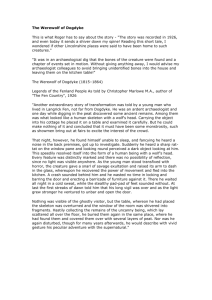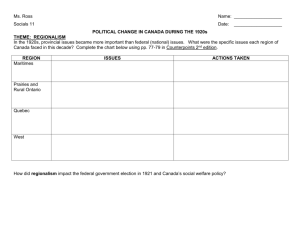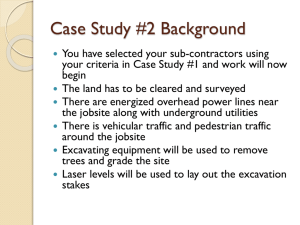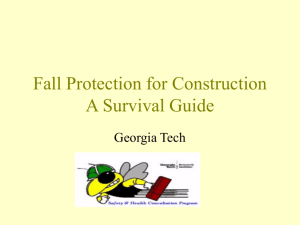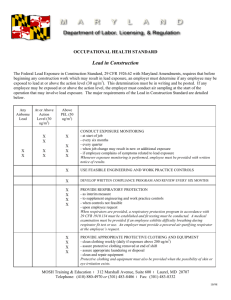WESTERN ILLINOIS UNIVERSITY William R. Cupples ENGINEERING TECHNOLOGY
advertisement
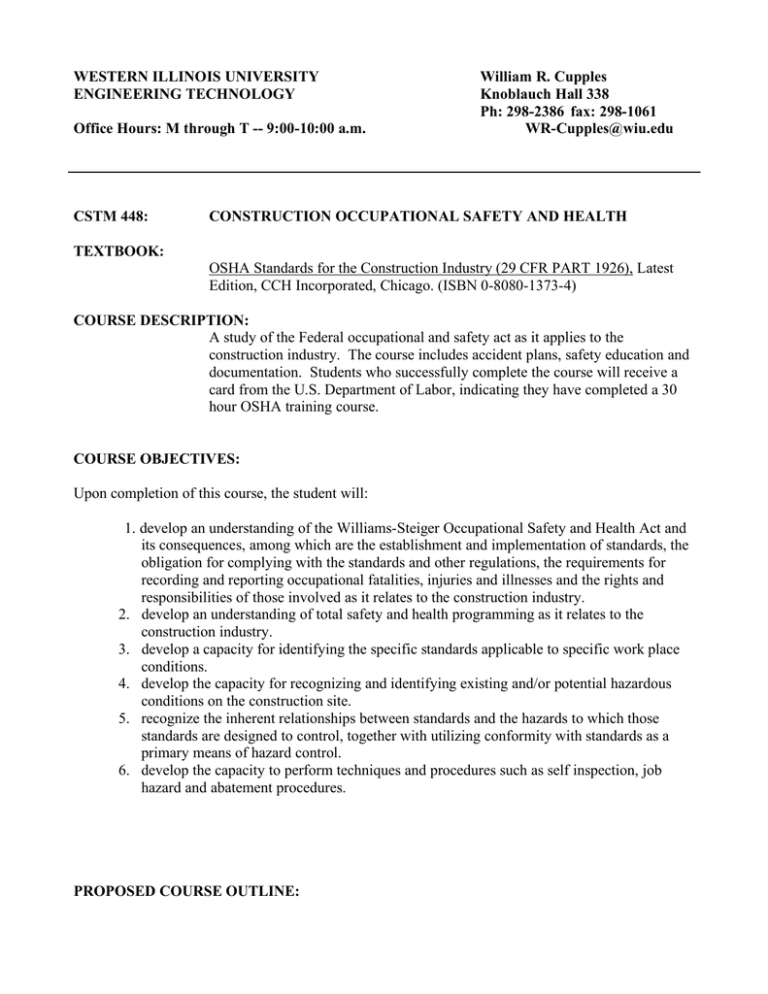
WESTERN ILLINOIS UNIVERSITY ENGINEERING TECHNOLOGY Office Hours: M through T -- 9:00-10:00 a.m. CSTM 448: William R. Cupples Knoblauch Hall 338 Ph: 298-2386 fax: 298-1061 WR-Cupples@wiu.edu CONSTRUCTION OCCUPATIONAL SAFETY AND HEALTH TEXTBOOK: OSHA Standards for the Construction Industry (29 CFR PART 1926), Latest Edition, CCH Incorporated, Chicago. (ISBN 0-8080-1373-4) COURSE DESCRIPTION: A study of the Federal occupational and safety act as it applies to the construction industry. The course includes accident plans, safety education and documentation. Students who successfully complete the course will receive a card from the U.S. Department of Labor, indicating they have completed a 30 hour OSHA training course. COURSE OBJECTIVES: Upon completion of this course, the student will: 1. develop an understanding of the Williams-Steiger Occupational Safety and Health Act and its consequences, among which are the establishment and implementation of standards, the obligation for complying with the standards and other regulations, the requirements for recording and reporting occupational fatalities, injuries and illnesses and the rights and responsibilities of those involved as it relates to the construction industry. 2. develop an understanding of total safety and health programming as it relates to the construction industry. 3. develop a capacity for identifying the specific standards applicable to specific work place conditions. 4. develop the capacity for recognizing and identifying existing and/or potential hazardous conditions on the construction site. 5. recognize the inherent relationships between standards and the hazards to which those standards are designed to control, together with utilizing conformity with standards as a primary means of hazard control. 6. develop the capacity to perform techniques and procedures such as self inspection, job hazard and abatement procedures. PROPOSED COURSE OUTLINE: 1. Excerpts from 1910 2. Subpart A -- General -- 1926.1 through 1926.5 2. Subpart B -- General Interpretations -- 1926.10 through 1926.16 3. Subpart C – General Safety and Health Provisions – 1926.20 through 1926.35 4. Subpart D – Occupational Health and Environmental Controls – 1926.56 through 1926.66 5. Subpart e – Personal Protective and Life Saving Equipment – 1926.95 through 1926.107 6. Subpart F – Fire Protection and Prevention – 1926.150 through 1926.155 7. Subpart G – Signs, Signals, and Barricades – 1926.200 through 1926.203 8. Subpart H – Materials Handling, Storage, Use and Disposal – 1926.250 through 1926 252 9. Subpart I -- Tools, Hand and Power – 1926.300 through 1926.307 10. Subpart J – Welding and Cutting – 1926.350 through 1926.354 11. Subpart K – Electrical – 1926.400 through 1926.449 12. Subpart L – Scaffolds – 1926.450 through 1926.454 13. Subpart M – Fall Protection – 1926.500 through 1926.503 14. Subpart N – Cranes, Derricks, Hoists Elevators and Conveyors 1926.550 through 1926.555 15. Subpart O – Motor Vehicles, Mechanized Equipment & Marine Operations – 1926.600 through 1926.605 16. Subpart P – Excavations -- 1926.650 through 1926.652 17. Subpart Q -- Concrete and Masonry Construction – 1926.700 through 1926.706 18. Subpart R – Steel Erection – 1926.750 through 1926.761 19. Subpart S – Underground Construction, Caissons, Cofferdams and Compressed Air – 1926.800 through 1926.804 20. Subpart T – Demolition – 1926.850 through 1926.860 21. Subpart U – Blasting and the Use of Explosives – 1926.900 through 1926.914 22. Subpart V – Power Transmission and Distribution – 1926.950 through 1926.960 23. Subpart W -- Rollover Protective Structures; Overhead Protection – 1926.1000 through 1926.1003 24. Subpart X – Ladders and Stairways – 1926.1050 through 1926.1060 25. Subpart Z – Toxic and Hazardous Substances – 1926.1100 through 1926.1152 26. 29 CFR 1903 -- Inspections, Citations and Proposed Penalties 27. 29 CFR 1904 – Recording and Reporting Occupational Injuries and Illnesses ASSIGNMENTS AND CLASS ACTIVITIES: 1. Students shall select a course related topic, prepare a Power Point presentation and present the topic, in a professional manner, to the class. Presentations will be evaluated by all class members using an instructor designed rubric. 2. Students will identify and discuss two safety incidents related to the construction industry that appear, or have appeared, in the media. 3. Students are expected to finish all assignments and actively participate in class discussions. 4. All late work will penalized by 20% for each delayed class meeting. ATTENDANCE/PARTICIPATION: This is a lecture course. Class will begin promptly as scheduled. You will be expected to attend all scheduled lecture sessions and roll will be taken at the beginning of each class. If you are not in the classroom when roll is taken, you will be considered absent from the class meeting. If you are unable to attend a session, let the instructor know as soon as possible. You are responsible to make up any work missed due to an absence. If you are absent from an exam or materials were collected when you were absent, you must provide information of your whereabouts if the absence will be accepted as excused. It is then up to the instructor as if the absence will be excused. If you have an appointment on a scheduled test date, you must let the instructor know in advance or the absence will not be excused. GRADE REPORTS: This course is graded point-for-point. Unless otherwise noted, each test answer will be worth one point and each homework answer will be worth one point. At the end of the semester the total number of points accumulated by each student will be added. This number will then be divided into the total number of points possible to determine a percentage. This percentage will correspond to a letter grade using the following criteria: 96-100% = A below 65% = F 86-95% = B 76-85% = C 66-75% = D Please save all assignments after they are graded and returned. Mistakes can inadvertently be made during the grade recording process and if a question should arise about your grade, it will be easier to absolve if all graded and returned work is available. STUDENTS WITH DISABILITIES: If there is any student in this class who has need for test-taking, or other, accommodations due to a disability, please feel free to discuss this with your instructor.
